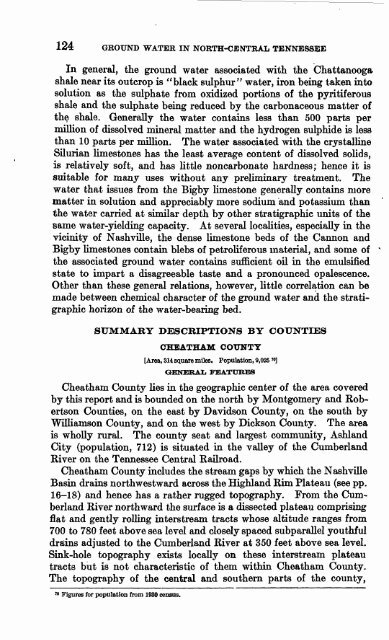GROUND WATER IN NORTH-CENTRAL TENNESSEE
GROUND WATER IN NORTH-CENTRAL TENNESSEE
GROUND WATER IN NORTH-CENTRAL TENNESSEE
You also want an ePaper? Increase the reach of your titles
YUMPU automatically turns print PDFs into web optimized ePapers that Google loves.
124 <strong>GROUND</strong> <strong>WATER</strong> <strong>IN</strong> <strong>NORTH</strong>-<strong>CENTRAL</strong> <strong>TENNESSEE</strong><br />
In general, the ground water associated with the Chattanooga<br />
shale near its outcrop is "black sulphur" water, iron being taken into<br />
solution as the sulphate from oxidized portions of the pyritiferous<br />
shale and the sulphate being reduced by the carbonaceous matter of<br />
the shale. Generally the water contains less than 500 parts per<br />
million of dissolved mineral matter and the hydrogen sulphide is less<br />
than 10 parts per million. The water associated with the crystalline<br />
Silurian limestones has the least average content of dissolved solids,<br />
is relatively soft, and has little noncarbonate hardness; hence it is<br />
suitable for many uses without any preliminary treatment. The<br />
water that issues from the Bigby limestone generally contains more<br />
matter in solution and appreciably more sodium and potassium than<br />
the water carried at similar depth by other stratigraphic units of the<br />
same water-yielding capacity. At several localities, especially in the<br />
vicinity of Nashville, the dense limestone beds of the Cannon and<br />
Bigby limestones contain blebs of petroliferous material, and some of<br />
the associated ground water contains sufficient oil in the emulsified<br />
state to impart a disagreeable taste and a pronounced opalescence.<br />
Other than these general relations, however, little correlation can be<br />
made between chemical character of the ground water and the strati-<br />
graphic horizon of the water-bearing bed.<br />
SUMMARY DESCRIPTIONS BY COUNTIES<br />
CHEATBAM COUNTY<br />
[Area, 314 square miles. Population, 9,025 ]<br />
GENERAL FEATURES<br />
Cheatham County lies in the geographic center of the area covered<br />
by this report and is bounded on the north by Montgomery and Rob-<br />
ertson Counties, on the east by Davidson County, on the south by<br />
Williamson County, and on the west by Dickson County. The area<br />
is wholly rural. The county seat and largest community, Ashland<br />
City (population, 712) is situated in the valley of the Cumberland<br />
River on the Tennessee Central Railroad.<br />
Cheatham County includes the stream gaps by which the Nashville<br />
Basin drains northwestward across the Highland Rim Plateau (see pp.<br />
16-18) and hence has a rather rugged topography. From the Cum<br />
berland River northward the surface is a dissected plateau comprising<br />
flat and gently rolling interstream tracts whose altitude ranges from<br />
700 to 780 feet above sea level and closely spaced subparallel youthful<br />
drains adjusted to the Cumberland River at 350 feet above sea level.<br />
Sink-hole topography exists locally on these interstream plateau<br />
tracts but is not characteristic of them within Cheatham County.<br />
The topography of the central and southern parts of the county,<br />
'» Figures for population from 1930 census.

















